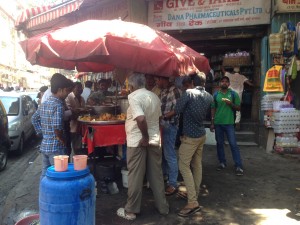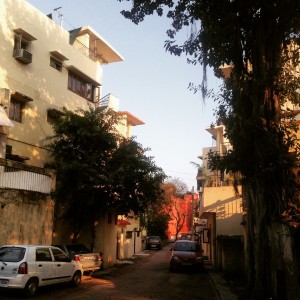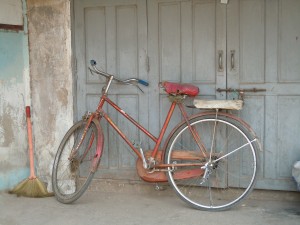Like a friendship or a romance, my relationship with India is a complicated one. Every day she takes me on a roller coaster ride of thrilling, ecstatic, beautiful highs and frustrated, hot and dirty lows. There’s something about the spirit of this country that is unlike any other place I’ve ever visited. India: she gets under your skin.
It feels every day I spend here, I discover another wildly weird, amazing, annoying, or hilarious thing about this great country. Here’s a list her idiosyncrasies that I love and love to hate.
(Most of these observations are based on my time spent in Delhi, and they are just that – personal observations – based on just a brief few months of being here.)
Hospitality
The people in India are overwhelmingly hospitable. Everyone I meet invites me to their home for a meal or offers up their contact information so I can get in touch should I ever need anything. When I wanted to do yoga, I was invited to attend a new friend’s private yoga class in her home. When I expressed an interest in food, I was invited over for a traditional home cooked lunch and brought out for dinners at some of the capital’s best restaurants. When I mentioned that I was going on a trip to Mumbai I was connected with a girl who lives there and she graciously welcomed me into her home and played tour guide for my entire stay. When I was in Bombay I got countless messages from my friends back in Delhi sharing advice on what to see and do and contact information of their friends in the city. A woman noticed me sitting alone on a train from Mumbai to Delhi and invited me to sit with her and her friend for dinner and then suggested I move down to their compartment to sleep (for safety’s sake). People are genuine in their offers and everyone has connections and is excited to share them. It is lovely to feel so welcomed into a country and a culture. It is through accepting these invitations that I have been able to catch a glimpse of India from inside its homes and its families – a side of the country I’ve never seen before and I’ve got to say, its beautiful from in here.
Gas, Nose Picking, Bum Picking and Public Urination
Forgive me for speaking of it but it can be a bit shocking when the sound of a large belch or loud fart reverberates through my office but here in India, they don’t have the same shame about bodily function. People on the street pick their noses and their bums unabashedly. Literally everywhere you turn in Delhi, there is a man standing with his legs apart, peeing. Coming from the West, it can be scandalizing but upon further reflection I think perhaps it’s also kind of liberating. This observation also got me thinking about how bizarre societies are in what they chose is “rude.” In India, it’s okay for men to whip out their penises for a quick pee whenever they please but god forbid a young woman walk around with her legs or shoulders out. No problem if you want to pick your nose on the bus sneak a smooch with your lover on the street and, yikes! I imagine coming from a country like India, visiting the West would reveal some equally bizarre contradictions. In the West you can’t eat with your hands. It’s okay for couples to be lovey-dovey but not common for heterosexual men to display affection towards one another. It’s not polite to be more than 15 minutes late. For an Indian, I imagine this would be as confusing as the burping is to me.
Most things are accomplished through personal, face-to-face connections.
In India, it’s all based on who you know. If you need something, you’re most likely going to get it by talking to a guy who knows a guy. I’ve been lucky enough to fall in with a group of people here who know people so this element of Indian culture has worked to my advantage and provided many cool connections and experiences. However, I see the flaw in a system where the connected remain in power, a realm unconnected can’t easily breach.
People are quick to open up.
It doesn’t take long for people here to breach topics that at home, would be considered inappropriate to discuss on a first meeting. Perhaps it has to do with the fact that people in India make fast friends. When you watch meetings on trains or in cafés, it doesn’t take long before the conversation turns into a passionate discussion of religion, rape and politics. And, what’s remarkable is, I’ve never seen these exchanges get mean. People feel free to explicitly and enthusiastically share their opinions. It’s refreshing and enlightening because even after being here a short time, you get an idea of where people stand on important issues.
Lack of Personal Space
It’s no surprise that with 1.3 billion people, this country is crowded. As a result, people here seem much less sensitive to touching. At home we exist in a bubble of personal space that is rarely breached. Here, people do not hesitate to tap, grab, push or lean on you when you’re nearby. It’s one thing I’ve struggled to get used to because while I never considered myself someone adverse to human contact, there is something violating about being tugged on by beggar or body slammed by a fellow passenger.
Singing in Public
People are always spontaneously breaking into song. In India, there is obviously not the same kind of shame and reservations around singing aloud. It’s so lovely to be serenaded by the voices of random strangers singing their hearts out as they stroll to work, drive their auto or simply sit and watch the world go by.
Bargaining
Haggling is a sport. And if you’re going to make it here, you’ve got to get good at it. It can be exhausting and annoying but it’s not really as scary as it seems. What I’ve discovered is that the negotiation between a customer and anything walla is just as much a means of connecting, as it is a way to set the price. My perception is that part of the culture of bargaining lies in the entertainment value. Selling things all day long is tedious (anyone who has worked in retail can likely attest to this) and the exchange that comes with making a sale is enhanced by the thrill of trying to get a good price. With this in mind, bargaining in India should always be approached with a smile. When a walla knows that you are in on the game, you’re much more likely to get a good price and have a positive shopping experience. It’s also important to remember, no one will sell you anything at a loss so you don’t worry about getting too low a price. Be brutal but friendly.
IST
Indian Standard Time (IST) generally runs an hour or so behind. This system works well for me because I am chronically late. Nothing can be accomplished quickly and getting anywhere takes way longer than you can imagine. “Five minutes, madam.” can mean anything from 10 minutes to an hour or more. Living this way can be frustrating but once you’ve accepted it, it’s actually kind of nice. It has helped me calm down and improved my ability to roll with the punches (a very good life skill, I think). In North America everything is go, go, go. Our systems and businesses are constantly striving to achieve efficiency. In India, the hustle bustle is constant at yet, remarkably, there is still a lot of time spent sitting around. Work hours are long but things are accomplished in a very round about way and much time is spent socializing, delegating, negotiating and waiting.
Communication is passive.
In North America, we are all about explicit communication. Terms are clearly outlined, help is straightforwardly offered and questions are plainly answered. Communication India is anything but clear. Often, simple flick of the head is all the response you will get from an auto driver, shop merchant or street vendor. Just because someone hasn’t responded or acknowledged you directly, doesn’t mean they haven’t heard your request. Things are done just so, and if you can relax, the vendor, driver or shopkeeper do what you’ve asked or take you where you need to go, eventually. No need to push, no need to ask again. Just like IST, it’s a good lesson in patience.
Auto drivers who don’t want to drive you home.
I’m always shocked when I ask an auto to take me somewhere and they flat out refuse by just put-putting away. This is a distinctly Delhi phenomenon. While technically it’s illegal (they have to pick you up) if you’re not going somewhere an auto driver feels like heading, most are more than happy to simply drive away. Every time it happens I’m left standing on the side of the road feeling stupid and oddly hurt by the driver’s rejection.
Pushy Cues
I hate pushy cues. Raised in a place where everyone always politely lines up in spacious cues, it’s an adjustment to get used to ramming your way to the front of a line. But, it’s the only way to get what you need. If you leave that 60cm of courtesy space between you and the person in front of you, you’ll never get to the front of the line.
Everyone wants to help… you all the time.
If you ask for directions, it’s rare that anyone will say that they don’t know. Even if they have no idea where you’re headed, Indian people are so keen to help they’ll often “assist” you regardless. And so, despite of their knowledge (or lack thereof) they will happily point you in a direction. You learn quickly that it’s good to ask for a second opinion. Additionally, people want to help you even when you don’t need help. If you’re haggling with an auto or negotiating with a vendor, it’s not uncommon for a small crowd to gather, everyone trying to offer their two cents. Again, the sentiment is nice but sometimes I can’t help but feel frustrated because c’mon, I’ve got things under control!
Food
This one needs no explanation. The food in this country is delectable and diverse. Food is everywhere and people relish eating. Here is an interesting study about the science of what makes Indian food so delicious and unique on a molecular level.
Honking
Coming from a country where horns mean something, it can be hard to adjust to the incessant racket of horns that is Delhi roads. Cars constantly assert their presence by beeping – beep to pass, beep if someone’s in your way, beep if you see a pedestrian a kilometre ahead, beep if you feel like dancing. It gets under my skin when as a pedestrian you feel bullied by the noise. “YES I see you hurdling towards me and NO you’re not going to hit me!” so why honk!? Otherwise, you get used to the noise.
Pushing the Sale of Anything and Everything
Waiting in an auto at red lights is almost like a trip to the mall. A man comes by with a pile of pirated novels, a little girl offers you a bouquet of flowers, a kid pedals sun blockers for your car window, an older man sells a variety of electronics chargers. What really amuses me, however, is the completely senseless items you often see on offer and the passion with which the salesmen push them. What on earth would I do with a splash paint balloon the size of a small child? The concept that no matter how low the price, I simply don’t want what they’re selling doesn’t seem to exist in the mind of these balloon pushers. It can be a little annoying to assure them a hundred times that you’re really, truly not interested but armed with an understanding of the hilarity of the situation, it’s easier to use it as an opportunity for a good laugh.



